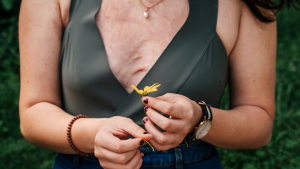
Back in February, I had an accident. I tripped over a metal grate abandoned on the pavement and went flying, landed heavily on my front and while my coat, my sunglasses and my gloves protected most of my body and face, my knees, which were only covered by a pair of workout leggings took the brunt. The right knee was grazed superficially, but the left knee had an enormous gash which required seven stitches.
Why am I telling you this?
Well, just the other day I was looking at the massive scar tissue that’s built up over that wound. It’s ugly, large and raised; puckered in places and dark enough to stand out in sharp contrast to the skin of my knee. It has also taken nearly four months to heal properly because of how deep the wound was. It still twinges occasionally, and bending at my knees is quite uncomfortable.
My body is a repository of scars. With a tendency for keloids (those ugly raised overgrowths of scar tissue), I can trace my history of accidents, injuries and surgeries through all the lumpy, knotty cicatrix on my skin. There is a thin spindly one on the middle finger of my left hand. A dog bite that involved a tussle over a pencil with my angry pet. The horizontal lump on my chest that was a collision with the handbrake of an old-fashioned bicycle. The one behind my right knee that I can’t for the life of me remember how I obtained. And the one just below my tummy, when my distressed infant was cut out of my womb in an emergency C-Section. Each scar has a memory attached to it; each scar is a little bit of me.
But what of the scar tissue that isn’t visible? What of the wounds that run so deep that no amount of time can overlay the pain?
There is the loss of my mother – the deepest cut of all. A reality that no one can escape from, but given time, can come to terms with. Losing her at twenty-seven meant that I never had the years that would have made her loss a bit more bearable. Those years when we could have grown together, when she could have guided me in my marriage, been there for me when I became a mother; when I could have understood her more fully as a woman and when I could have taken care of her as an old lady. That was denied to me through a combination of ill-health (hers) and circumstances (mine).
That loss feels all the more poignant today as I remember her in the week of her birthday. Had she lived, she would have been eighty-one. Maybe losing her in her eighties wouldn’t have hurt as much. Or maybe it would have. Maybe loss is loss, no matter when it happens. And those scars, the ones that stay hidden from sight, are the keloids on my soul.
The month of June has seen bad news come in from so many quarters, it’s been overwhelming. From losing a school friend through Covid, to a colleague through pancreatitis, a family acquaintance through a heart attack and the twenty-year-old son of my husband’s former boss unexpectedly, it has been a tsunami of devastation. These are gaping wounds that refuse to fill. There is grief, anger and shock. There is also an acute realisation of how fragile life really is, and how nothing and nobody can be taken for granted.
My pain is once removed, but what of those who are in its immediate vicinity? What of the wife who has lost her husband, the mother who has lost her son, the son who has lost the only parent he knew, the company that has lost their visionary leader? How long will it take for the scar tissue to build there? And will it stay – ugly, raised and twisted – revealing the depth of those wounds?
Life is pain because pain comes from attachment and love. No one is immune to it, and nor should we be. How arid it would be to live in a world devoid of any feeling. Each wound, each scar, is a testament to our time spent in this world, loving and living.
And those keloids on our souls? That’s where our loved ones reside.

